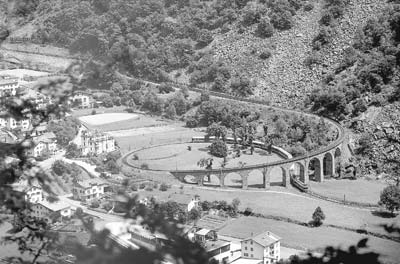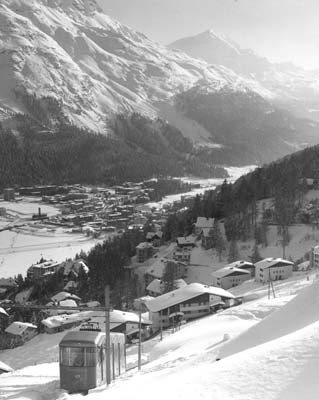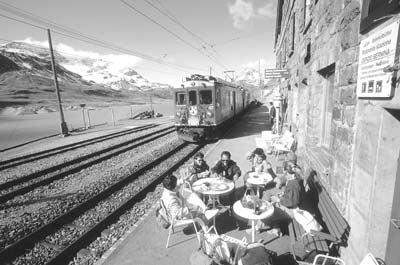New RhB summer timetables
This item appears on page 70 of the May 2008 issue.
The Rhaetian Railroad (RhB) in Switzerland revised its 2008 summer (May 10-Oct. 19) timetable. All four Glacier Express trains from Zermatt will detour via Chur on their way to St. Moritz, and three Bernina Express trains will not originate in Chur but instead will run between St. Moritz and Tirano. One Bernina Express train will come from Chur and one from Davos, both of which will travel via Pontresina (not St. Moritz) to Tirano.
UNESCO World Heritage Site candidature honors the enduring, high-altitude engineering landscape — a wonderland — of Switzerland’s Graubünden Canton and the most spectacular, technically innovative and harmonious narrow-gauge railroad.
At the end of the 19th century, historic railroad engineering and nearly miraculous construction of tunnels, loops and bridges conquered mountains and connected villages. The meter-gauge (in order to enable hairpin turns) RhB pioneered train travel with the longest narrow-gauge network in Europe. RhB is a private company. It celebrated the 100th birthday of its first line in 1989.
The Landwasser moment
The most exciting moment while riding the Glacier Express to St. Moritz occurs during the 6.5-mile section from Tiefencastel to Filisur. First, 6.1 miles out of Tiefencastel, trains cross the Schmittentobel Viaduct’s seven arches, rising 118 feet.
Then, suddenly out of a 164-foot tunnel, the Glacier Express trains quickly bear down on the five classic arches of the elegant 1903 Landwasser Viaduct curving to the right over the Landwasser River far below.
The viaduct’s 400-foot span rests on 213-foot piers, and without railings, trains speed across the Landwasser Viaduct’s celebrated southern arch and plunge full-throttle into the black hole of the Landwasser Tunnel.
The most difficult terrain of the line is the 5.8-mile segment from Filisur to Bergün. Trains must climb a gradient of one for every 28 and pass through 14 tunnels and over eight viaducts.
The 1903 section past Bergün to Preda is technically the most interesting. The direct distance to Preda from Bergün is four miles, but surveyors bent the line into such extraordinary contortions of loops and spirals that trains actually travel 7.6 miles, including 1.7 miles through seven tunnels. If trains climbed directly, they would climb one for every 16, but the expensive spirals and reversals of direction safely reduce their gradient to one in 30.
Many admirers of the Landwasser Viaduct break their journey at Filisur Station (3,556 feet) and follow the signs from the train station down the marked footpath to inspect the dramatic structure from the viewing point below. They later board a local train at Wiesen.
Upper Engadin
Emerging from the 3.6-mile Albula Tunnel, the highest (6,242 feet) principal tunnel through the Alps and the most expensive and difficult engineering work of the RhB, the Glacier Express trains arrive in the Upper Engadin Valley, with an average altitude of 5,500 feet, clear skies and dry, light breezes.
Engadin architecture is so unique and bright that it sets the region off from the rest of Switzerland more distinctly than if the train had crossed a frontier. The houses are white and thick-walled, with small, irregularly spaced windows widening outward.
Their most distinctive feature is their sgraffito. Masons covered rough, gray plaster with coats of white limewash and then artfully scraped away the wash to bring out charming gray scrolls, interesting geometries and fascinating embroideries.
St. Moritz (5,939 feet) is the eastern terminus of the Glacier Express and the northern terminus of the Bernina Express. The original St. Moritz train station of 1904 was modernized in 1927 and has been periodically expanded since. Most recently, it underwent a major modernization in preparation for the Alpine World Ski Championships of 2003.
St Moritz likes to think of itself as “Top of the World,” not for elevation but for quality and prestige. In addition to aerial cableways (23 in winter, seven in summer), a 2-stage funicular rises from St. Moritz to Corviglia. The 1.2-meter-gauge first section to Chantarella carries 1,430 feet and the 1.44-meter-gauge second section continues 5,300 feet to an elevation of 8,164 feet.
Shortly after departing St. Moritz and high above the timberline, Bernina Express trains reach the summit at Ospizo Bernina (7,403 feet), where winter lasts seven months. They climbed 5,973 feet by simple adhesion — even more than any Swiss rack railroad — and reached the highest station in Switzerland served by adhesion railway.
Joy in the landscape
RhB’s Bernina Express trains, with narration and panoramic windows that wrap into the roof above passengers’ heads to reveal the peaks of the high Alps, so enhances passengers’ joy in the landscape that it would be many sightseers’ first European choice because of the stunning Alpine peaks, villages, thrilling twists and startling precipices. As well, it would be the train most railfans favor because of the technically exciting ride.
Lago Bianco on the right, covered by ice until late May, was originally four lakes but was dammed to form a reservoir for the Brusio power station, forcing the railroad to be moved some 30 feet higher. The former path runs along the edge of the lake.
From here, trains descend through the 630-foot Scala Tunnel, the Pozzo del Drago Tunnel (the dragon is rumored to lurk in the nearby lake) and an avalanche gallery to reach Alp Grüm (6,858 feet).
Alp Grüm Station is a popular jumping-off place for Alpine hiking and an amazing place for lunch. Lake Poschiavo is 4,231 feet below and only 6.8 miles away. Descending follows a route that required surveyors to perform near miracles.
To reach Poschiavo, trains must descend 4,034 feet in a horizontal distance of only 4.7 miles. Engineers solved this problem by designing a series of cautious, cascading cuts, circular tunnels, sharp zigzags and astonishing loops.
First, trains descend to the right in a semicircle, wheels screeching, below Alp Grüm Station into the 833-foot Palu Tunnel, in which they make a three-quarter turn and emerge down the mountain. For a second time they pass below Alp Grüm into the 948 Stabline Tunnel, emerging on the back slope of Alp Grüm before doubling back through the 745-foot Pila Tunnel and returning below the terrace for a third time.
In less than 10 minutes, the train has descended 1,305 feet from the restaurant at Alp Grüm to Cavaglia at 5,533 feet.
After passing Brusio, trains make one of the world’s most amazing loops across a raised, corkscrew stone viaduct having a radius of only 164 feet. Nearby highway traffic comes to a standstill while drivers and passengers watch the descent.
Take your passport
Trains then continue effortlessly down the valley, across a steel bridge over the pressure pipes of the Brusio power station (which generates electricity powering the line) to the Italian frontier. Passengers collect their Bernina Express certificates and walk a few steps into Tirano, Italy.
In Tirano they have time to feast on an Italian lunch on the main street (restaurants accept credit cards, so there is no need to exchange Swiss francs into euros) before boarding the 2:25 p.m. Bernina Express Bus to Lugano, in Switzerland’s Canton Ticino.
Lugano’s unique 1890 funicular consists of two half-sections rising to the summit of Monte San Salvatore (3,000 feet), a pair of meter-gauge funiculars in series climbing to the summit of Monte Brè (3,030 feet), and a short (722 feet), meter-gauge funicular descending from the federal railroad’s Lugano Station to the city.
For further information, log onto www.myswitzerland.com or www. rhb.ch.
The long-delayed and revised third edition of Brunhouse’s “Maverick Guide to Berlin,” published by Pelican, is now available online and from travel bookstores.



